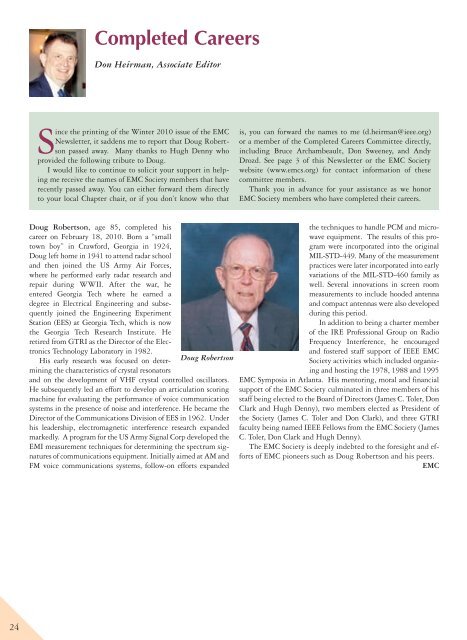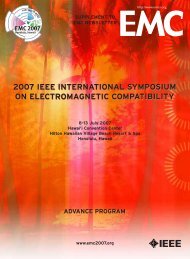Tutorial: EMC & Signal Integrity using SPICE, page 44 - IEEE EMC ...
Tutorial: EMC & Signal Integrity using SPICE, page 44 - IEEE EMC ...
Tutorial: EMC & Signal Integrity using SPICE, page 44 - IEEE EMC ...
Create successful ePaper yourself
Turn your PDF publications into a flip-book with our unique Google optimized e-Paper software.
24<br />
Completed Careers<br />
Don Heirman, Associate Editor<br />
Since the printing of the Winter 2010 issue of the <strong>EMC</strong><br />
Newsletter, it saddens me to report that Doug Robertson<br />
passed away. Many thanks to Hugh Denny who<br />
provided the following tribute to Doug.<br />
I would like to continue to solicit your support in helping<br />
me receive the names of <strong>EMC</strong> Society members that have<br />
recently passed away. You can either forward them directly<br />
to your local Chapter chair, or if you don’t know who that<br />
Doug Robertson, age 85, completed his<br />
career on February 18, 2010. Born a “small<br />
town boy” in Crawford, Georgia in 1924,<br />
Doug left home in 1941 to attend radar school<br />
and then joined the US Army Air Forces,<br />
where he performed early radar research and<br />
repair during WWII. After the war, he<br />
entered Georgia Tech where he earned a<br />
degree in Electrical Engineering and subsequently<br />
joined the Engineering Experiment<br />
Station (EES) at Georgia Tech, which is now<br />
the Georgia Tech Research Institute. He<br />
retired from GTRI as the Director of the Electronics<br />
Technology Laboratory in 1982.<br />
His early research was focused on deter- Doug Robertson<br />
mining the characteristics of crystal resonators<br />
and on the development of VHF crystal controlled oscillators.<br />
He subsequently led an effort to develop an articulation scoring<br />
machine for evaluating the performance of voice communication<br />
systems in the presence of noise and interference. He became the<br />
Director of the Communications Division of EES in 1962. Under<br />
his leadership, electromagnetic interference research expanded<br />
markedly. A program for the US Army <strong>Signal</strong> Corp developed the<br />
EMI measurement techniques for determining the spectrum signatures<br />
of communications equipment. Initially aimed at AM and<br />
FM voice communications systems, follow-on efforts expanded<br />
is, you can forward the names to me (d.heirman@ieee.org)<br />
or a member of the Completed Careers Committee directly,<br />
including Bruce Archambeault, Don Sweeney, and Andy<br />
Drozd. See <strong>page</strong> 3 of this Newsletter or the <strong>EMC</strong> Society<br />
website (www.emcs.org) for contact information of these<br />
committee members.<br />
Thank you in advance for your assistance as we honor<br />
<strong>EMC</strong> Society members who have completed their careers.<br />
the techniques to handle PCM and microwave<br />
equipment. The results of this program<br />
were incorporated into the original<br />
MIL-STD-<strong>44</strong>9. Many of the measurement<br />
practices were later incorporated into early<br />
variations of the MIL-STD-460 family as<br />
well. Several innovations in screen room<br />
measurements to include hooded antenna<br />
and compact antennas were also developed<br />
during this period.<br />
In addition to being a charter member<br />
of the IRE Professional Group on Radio<br />
Frequency Interference, he encouraged<br />
and fostered staff support of <strong>IEEE</strong> <strong>EMC</strong><br />
Society activities which included organizing<br />
and hosting the 1978, 1988 and 1995<br />
<strong>EMC</strong> Symposia in Atlanta. His mentoring, moral and financial<br />
support of the <strong>EMC</strong> Society culminated in three members of his<br />
staff being elected to the Board of Directors (James C. Toler, Don<br />
Clark and Hugh Denny), two members elected as President of<br />
the Society (James C. Toler and Don Clark), and three GTRI<br />
faculty being named <strong>IEEE</strong> Fellows from the <strong>EMC</strong> Society (James<br />
C. Toler, Don Clark and Hugh Denny).<br />
The <strong>EMC</strong> Society is deeply indebted to the foresight and efforts<br />
of <strong>EMC</strong> pioneers such as Doug Robertson and his peers.<br />
<strong>EMC</strong>

















